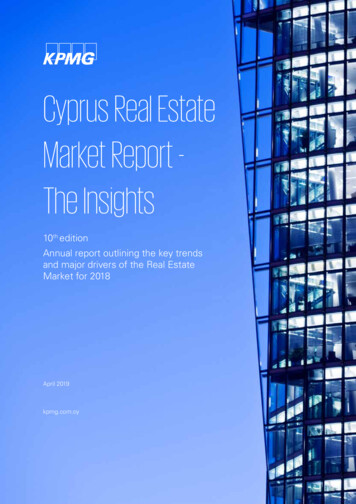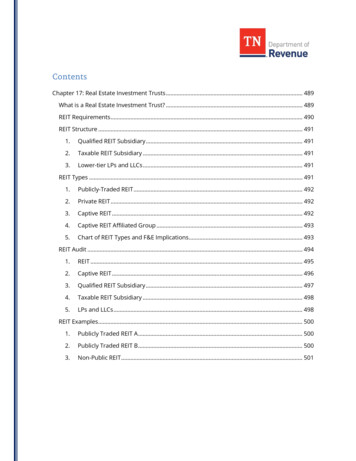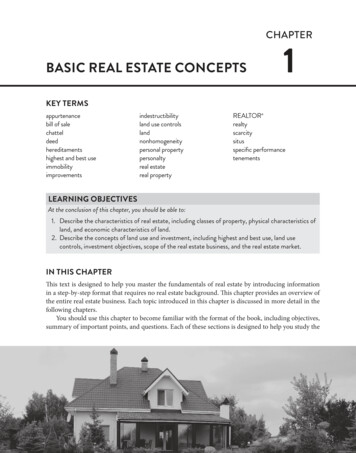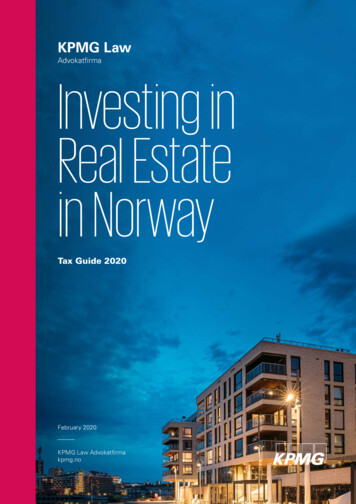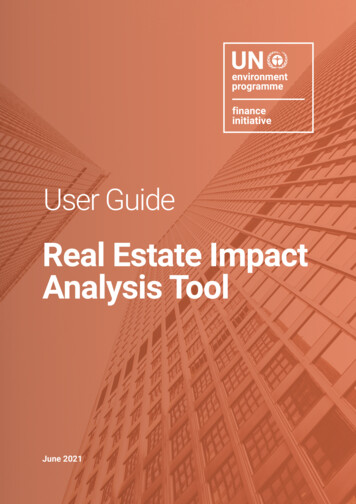
Transcription
User GuideReal Estate ImpactAnalysis ToolJune 2021Portfolio Impact Analysis Tool for Banks - Version 2 - User Guide 1
Copyright United Nations Environment Programme, 2021The UNEP FI Real Estate Impact Analysis Tool and its User Guide may be reproduced inwhole or in part and in any form for non-commercial educational or non-profit purposeswithout special permission from the copyright holder, provided acknowledgement ofthe source is made. Please contact the United Nations Environment Programme fora tailored acknowledgment statement. The United Nations Environment Programmewould appreciate receiving an electronic copy of any materials (publications, resources,tools) that use all or part of this resource either directly or as a source of inspiration.No use of the UNEP FI Real Estate Impact Analysis Tool and its User Guide may be madefor resale or for any other commercial purpose whatsoever without prior permission inwriting from the United Nations Environment Programme.About UNEP FI’s Impact Analysis ToolsUNEP FI’s Impact Analysis Tools are based on a unique Holistic Impact Methodologyderived from UNEP FI’s Principles for Positive Impact Finance. These are a meta-framework to enable the financing of the SDGs. As per the Principles, Positive Impact Finance is:‘that which serves to finance Positive Impact Business. It is that which serves to delivera positive contribution to one or more of the three pillars of sustainable development(economic, environmental and social), once any potential negative impacts to any ofthe pillars have been duly identified and mitigated.’Impact Analysis Tools currently available: Portfolio Impact Analysis Tool for Banks Corporate Impact Analysis Tool Real Estate Impact Analysis ToolIn the pipeline: Impact Analysis Tool for Investment Portfolios (2021)About the Real Estate Impact Analysis ToolThe Real Estate Impact Analysis Tool was developed as a follow-on to the Positive ImpactReal Estate Investment Framework published by the UNEP FI’s Property Working Group incollaboration with other investor network organisations in 2018. The Tool expands on andfurther operationalises the work undertaken in 2018.The development process was conducted collaboratively through a dedicated ImpactAnalysis Working Group made up of members of the UNEP FI’s Property Working Group,including users of the Positive Impact Real Estate Investment Framework, as well asrepresentatives from UNEP FI’s banking membership seeking to refine the impact analysis processes they have underway to meet the requirements of the Principles for Responsible Banking.The Real Estate Impact Analysis Tool is a live resource, designed to evolve over time in orderto constantly respond to practitioner feedback and to improve user experience and benefits.Portfolio Impact Analysis Tool for Banks - Version 2 - User Guide 2
AcknowledgementsUNEP FI would like to acknowledge the members of the 2020–21 Real Estate ImpactAnalysis Working Group for their piloting, testing and guidance throughout the development process:District HonorReal Estate ImpactInvesting & CommunityDevelopment FinanceThe Project Team for the development of the UNEP FI Real Estate Impact Analysis tooland its User Guide was made up of: Careen Abb, Programme Lead; Costanza Ghera,Content Manager; James Boakes, Intern from the Impact & SDG Team and; MatthewUlterino, Property Investment Project Coordinator from the Investment Team.Portfolio Impact Analysis Tool for Banks - Version 2 - User Guide 3
Content OverviewAcknowledgements.3Index of Figures and Tables.3A.The UNEP FI Holistic Impact Analysis Methodology.41.2.3.4.B.Description. 4Methodological Principles. 5Benefits of holistic impact analysis.8Approaches to applying the UNEP FI Holistic Impact Analysis Methodology. 9Holistic Impact Analysis for Real Estate.101.2.3.Positive Impact Real Estate Framework.10How holistic impact analysis compares to other portfolio analyses. 11Complementary resources. 11C.Introduction to the Real Estate Impact Analysis Tool.12D.Using the UNEP FI Portfolio Impact Analysis Tool Step by Step – Asset Level. 171.2.E.Using the UNEP FI Real Estate Impact Analysis Tool Step by Step – Fund/Portfolio Level.361.2.F.Phase 1 – Impact Identification.17Phase 2 – Impact Assessment.30Phase 1 – Impact Identification.36Phase 2 – Impact Assessment.50Annexes.56Annex 1. UNEP FI Impact Radar.56Annex 2. Key concepts. 61Annex 3. Reference Resources from the Positive Impact Real Estate InvestmentFramework.65Index of Figures and TablesFigure 1:Figure 2:Figure 3:Figure 4:Figure 5:Overview of Holistic Impact Analysis. 5Single Asset Analysis Workflow.13Portfolio/Fund Analysis Workflow.14UNEP FI impact Radar.56The 22 Impact Areas of the UNEP FI Impact Radar & the SDGs.60Portfolio Impact Analysis Tool for Banks - Version 2 - User GuideContent Overview4
A. The UNEP FI HolisticImpact AnalysisMethodology1. DescriptionThe UNEP FI Holistic Impact Analysis Methodology is a two-step process to understandand manage actual and potential positive and negative impacts across the spectrum ofenvironmental, social and economic issues.Step one consists in understanding the impact areas and topics (e.g., employment,climate, economic convergence) that are associated with the object of analysis (e.g.,a portfolio, a corporate’s business activities, or a physical asset such as real estate). Italso involves understanding the impact needs that exist in the location/s that the objectof analysis finds itself in or interacts with, so as to contextualize its impact profile anddetermine its most significant impact areas. This is referred to as Impact Identification.Step two consists in understanding the actual impacts of the object of analysis – are thepotential impacts identified in step one happening in reality? To what extent? What doesthis tell us about impact performance, especially in terms of responding to real impactneeds and gaps in the location/s that the object of analysis finds itself in or interactswith? This is referred to as Impact Assessment.1. ImpactIdentification2. ImpactAssessmentActionIdentification of impactareas associated with theobject of analysis, as wellas impact needs in thelocation/s the object ofanalysis finds itself in orinteracts with.Determination ofactual impacts andassessment ofimpact performancevis-à-vis mostsignificant impactareas.Definition ofstrategies,establishmentof action plansand target setting(financial and extrafinancial).Figure 1: Overview of Holistic Impact AnalysisPortfolio Impact Analysis Tool for Banks - Version 2 - User GuideThe UNEP FI Holistic Impact Analysis Methodology5
The purpose of the Holistic Impact Analysis Methodology is to enable concrete action.Out of the insights generated by the analysis, users are empowered to define strategies,establish action plans and set meaningful financial and extra-financial targets.2. Methodological PrinciplesFive key principles underpin the methodology. These are outlined below, with pointers tohow they translate into the specific applications of the methodology in UNEP FI’s Portfolio Impact Analysis Tool and other related Tools.HolisticHolistic impact analysis consists in understanding the actual and potential positiveand negative impacts associated with a business, asset, project or portfolio across thespectrum of environmental, social and economic issues. This ensures that interconnections between sustainability topics can be both managed and leveraged.The 22 impact areas are drawn from the UNEP FI Impact Radar (2019). These cover thethree pillars of sustainable development: economic, environmental, social. They distil theSDGs into discreet topics for the specific purpose of impact analysis. For more information, please consult the Annex.ObjectiveThe methodology is based on an objective consideration of the impact drivers associated with the object of analysis. Below are the impact drivers considered for the units ofanalysis addressed by the different Tools.Banking PortfoliosInvestment Portfolios Client types Sectors Geography Asset categoriesAsset typesInvestment approachGeographyCorporatesReal Estate Company size/type Sectors Geography Asset typesAsset statusArea typesGeolocationEach of these drivers has been mapped out to the 22 impact areas in a series of impactmappings, all of which are based on existing research where available, and open toon-going consolidation via consultation with relevant stakeholders and experts. Furtherinformation on the current sources is available directly within the mappings, as well asin the Q&A items of the relevant parts of this document.Portfolio Impact Analysis Tool for Banks - Version 2 - User GuideThe UNEP FI Holistic Impact Analysis Methodology6
ContextualisedThe point of impact analysis is to be able to manage impacts, that is, to deliver positiveimpacts and address negative impacts to deliver on people’s needs, within planetaryboundaries and in an economically viable way.The assessment and consideration of needs so as to contextualise impacts is thereforeat the heart of the methodology.PracticalTailoredEvery institution and use case has its specificities. The methodology is built so as toallow for multiple levels of analysis and use-cases:Portfolio LevelCorporateAsset Bank Universal Consumer Business CIB Investment Large SME (pending) Real EstateProject(pending)Moreover, the Tools can be used in a variety of ways: Off the shelf Impact Radar and mappings can be used freely / independently Technical specifications are included in the Tool to facilitate uptake/adaptationdirectly within banks’ internal systemsInteroperableImpact management comprises many actions, for some of which a wealth of resourcesis available. The Tool workflows and resources have been built to maximise interoperability with these.MeasurementmethodologiesDisclosureValuation methodologiesShould be used to obtainthe data required in theperformance assessment segment of themethodology.The indicators and metricsof the main sustainabilitydisclosure frameworks(voluntary and regulatory)have been captured in theTools’ ‘Indicator Library’.Can use the Tools’ outputsas a starting point.Can be used as input tothe conclusion-drawing ofthe Tools.Portfolio Impact Analysis Tool for Banks - Version 2 - User GuideThe UNEP FI Holistic Impact Analysis Methodology7
IterativeFinally, the methodology is built to support an iterative process of impact analysis,whereby users develop the scope and granularity over time and successive rounds ofanalysis. The Tools are built to enable the development of in-house capability.Transparent & ComparableThe Tools are freely available for download on the UNEP FI website. Both the workflowsand resources (mappings) of the Tools are constructed in Excel and all technical specifications are documented for full transparency.3. Benefits of holistic impact analysisSustainability topics, from climate change to social and economic equalities, are numerous, and with every topic comes a host of measures and strategies that need to beconsidered and put in place. They are also interconnected and often in contradiction witheach other; thus, implementing climate mitigation measures can require accompanyingsocial measures, to ensure a ‘just transition’. In short, sustainability issues are a sourceof risk and opportunity that is difficult to fathom and to predict. This is where a holisticapproach can make a difference.Holistic impact analysis leads to an understanding of both the positive and negativeimpacts associated to the bank’s portfolio across sustainability topics. This holisticapproach enables a better anticipation of unintended consequences (i.e., better riskmanagement) and simultaneously facilitates the development of new business opportunities that leverage on the interconnections between impact topics. Adopting a globalview is also a way of making efficiency gains; it can save precious time and effort vis avis an incremental, topic by topic approach.The holistic impact analysis is first and foremost a Tool for enhanced business strategy:Applying holistic impact analysis at portfolio level, as per the PRB requirements is theultimate enabler of integrated commercial, financial and sustainability management.Portfolio Impact Analysis Tool for Banks - Version 2 - User GuideThe UNEP FI Holistic Impact Analysis Methodology8
4. Approaches to applying the UNEP FI HolisticImpact Analysis MethodologyThere are several options to apply the UNEP FI methodology:4.1 Using the UNEP FI Impact Analysis Tools Off-the shelf: the Portfolio Impact Analysis Tool for Banks and the Corporate ImpactAnalysis Tool are freely available from the UNEP FI website. The Portfolio Tool is available cross portfolio or per business line (business line specific versions will be madeavailable progressively throughout 2021). A Portfolio Tool for Investments and a RealEstate Impact Analysis Tool will be released in 2021. The different sections (e.g., scoping, cartography, needs assessment) and mappings(e.g., sector/impact map, indicator library) can be used freely / independently Technical specifications are available to facilitate uptake/adaptation directly withinbanks’ internal systems.4.2 Without directly using the UNEP FIPortfolio Impact Analysis Tool Even if you don’t use all or part of the Tools directly, you can follow the logic of theanalysis by ensuring that you root your analysis in a systematic, objective and transparent cross-sector and cross-impact view of your portfolio.Whichever the approach you use in your disclosures, make sure to specify clearly howyou proceeded and what resources you used.Portfolio Impact Analysis Tool for Banks - Version 2 - User GuideThe UNEP FI Holistic Impact Analysis Methodology9
B. Holistic ImpactAnalysis forReal Estate1. Positive Impact Real EstateInvestment FrameworkIn late 2018, UNEP FI’s Property Working Group in collaboration with other investornetwork organisations, published its Positive Impact Real Estate Investment Framework. The Framework was developed to support real estate investors in settinginstitutional practices and processes so that understanding of and taking action onpositive and negative impacts from real estate investment becomes fully integratedinto finance and management decision-making. The Framework is appropriate for useat any stage of the property investment cycle. It is structured around four investmentobjectives and offers a way for institutions to frame decision-making for more immediate-term investment activities and longer-term aspirations that derive from PositiveImpact’s holistic and impact-based approach. The four investment objectives are:1.Clarity of impact: does my impact-based approach clearly determine and describemy intended impacts and outcomes?2.Market and sustainable returns: does my investment approach meet market normsand fiduciary standards while tangibly contributing to sustainable development?3.Measurement of impact: do I have clear and transparent methodology(ies) tomeasure ex-ante and ex-post the expected outputs, and intended outcomes?4.Additional finance and/or impact flows: has this approach enabled my institutionto go beyond a ‘business as usual’ or ‘best practice as usual’ trajectory – has ityielded impact and finance flows which otherwise would not have been delivered?Does it cover underserved markets?Various decision-support questions and resources are included in the Framework,including a sample matrix of positive and negative impacts from real estate investment and management across the 22 impact areas of the UNEP FI Impact Radar andcorresponding high-level metrics and indicators.Portfolio Impact Analysis Tool for Banks - Version 2 - User GuideHolistic Impact Analysis for Real Estate10
The Real Estate Impact Analysis tool builds on and expands on the Framework, byofferings a hands-on, structured approach to impact identification and analysis, thussupporting institutions in establishing their asset and/or portfolio of impact outcomesand measuring and monitoring them.2. How holistic impact analysis builds upon ESGintegration practicesIndustry practices for ESG integration have tangibly yielded progress in property andinstitution performance against a wide range of environmental, social and governancemeasures and there are many platforms and resources available for institutions tomeasure and disclose results. Holistic impact analysis can improve upon these practices in the following ways. Processes and resources for measuring sustainability, either internally or externallysourced, are often restricted to positive benefits. Bringing forward methods and toolsfor identifying and measuring negative impacts of investment activities is part of thisholistic approach. The lesser attention to negative impact assessment may partly stem from existingstatutory processes in mature markets, i.e., requirements for environmental or socialimpact assessments during project planning as a condition of development approval.Compliance is thus considered a negative impact mitigator, whereas holistic impactanalysis and management seeks to move practices beyond ‘business as usual/best-practice as usual’ statutory levers. For many institutions, the SDGs are being used to frame intent and measure impactof their investments. Most SDG-related frameworks, however, start with the investment objective in sectoral terms—for example: resource efficient buildings, affordable/low-cost housing, health and care facilities, etc.—or move backwards from presentinvestment activities to nominating which SDGs those investments contribute to,rather than impact analysis. This differs from the ultimate objective of an impactbased approach which is to assess impact needs first, thus defining what investorscan influence through which types of products and activities.3. Complementary resourcesA summary of some of the strategy frameworks, methods, and tools related to impactspresently available, as compiled in the appendix of the Positive Impact Real Estate Investment Framework is included in the annex of the present document for ease of reference.Portfolio Impact Analysis Tool for Banks - Version 2 - User GuideHolistic Impact Analysis for Real Estate11
C. Introduction to theUNEP FI Real EstateImpact Analysis ToolThe Real Estate Impact Analysis Tool is an iterative input-output workflow built in Excel2013. It requires users to input data to describe their real estate asset, fund or portfolio (e.g.AUM per asset type (amount and percentage of total) and to reflect their current impactperformance (e.g. GHG emissions).The Tool uses the input data in combination with a set of in-built impact mappings toproduce a number of outputs, in particular a set of impact profiles by asset or by fund/profile, and to guide the user in identifying the asset or the fund/portfolio’s most significant impact areas, thus setting the basis for decision-making, strategy development andtarget-setting.Figure 3 below outlines the workflow of the Tool for the two levels of analysis, showingthe different phases (identification and assessment), the different steps within the phases,and the outputs of each phase. It also shows the in-built resources and which part of theprocess they feed into.Note on the scope of the ToolThe Real Estate Impact Analysis Tool enables you to perform holistic impact analysisat two different levels: Individual real estate assets (existing assets, renovations and new developments)This level of analysis is intended to support investment decision-making and the monitoring of impacts over time. Funds or Portfolios containing oruniquely made up of real estate assetsThis level of analysis is intended tosupport investors and financial institutions seeking to gain a cross-portfolioor fund-level view of the impacts of theirreal estate and to manage those funds/portfolios accordingly.Portfolio Impact Analysis Tool for Banks - Version 2 - User GuideIntroduction to the UNEP FI Real Estate Impact Analysis Tool Click here to listen to anexplanation of the workflows12
StartPhase 1 – Impact Identification1.1 Cartography Asset TypeArea TypeAsset StatusLocation1.2 Understanding Context1.3 Profilei. Country Level Baseline Resources for CountryNeeds Assessment Additional/ Further Resources forCountry Needs Assessmentii. Specific Locations Baseline Resources for LocationNeeds Assessment Additional/ Further Resources forLocation Needs Assessmenti. Impact Associations Asset Type Area Type Asset Statusii. Contextualisation and determinationof significant impact areas by impact areas by country neediii. Summary of significant impact areasPhase 2 – Impact Assessment2.1 Performance review2.2 Dashboard Summary of impact drivers Guidance for indicator selection Performance review & assessment Summary of impact drivers Summary of actions taken andtargets setFigure 2: Single Asset Analysis WorkflowPortfolio Impact Analysis Tool for Banks - Version 2 - User GuideIntroduction to the UNEP FI Real Estate Impact Analysis Tool13
StartPhase 1 – Impact Identification1.1 Cartography1.2 Understanding Context1.3 Profilesi. Dateii. Overviewiii. Fund/Portfolio by Fund/PortfolioView Intentionality Asset types Geolocationi. Country Level Baseline Resources for CountryNeeds Assessment Additional/ Further Resources forCountry Needs Assessmenti. Cross-fund/portfolios view Impact Associations Overview of Country and Locationneeds Summary of Significant ImpactAreasii. Specific Locations Baseline Resources for LocationNeeds Assessment Additional/ Further Resources forLocation Needs Assessmentii. Fund/portfolio view Impact Associations Overview of Country and Locationneeds Ranking of impact areas Review & Interpretation Determination of Significant ImpactAreasPhase 2 – Impact Assessment2.1 Performance review2.2 Dashboard Summary of impact drivers Guidance for indicator selection Performance review & assessment Selected impact areas/ topics Selected indicators, targets and timeframes Action pointsFigure 3: Portfolio/ Fund Analysis WorkflowPortfolio Impact Analysis Tool for Banks - Version 2 - User GuideIntroduction to the UNEP FI Real Estate Impact Analysis Tool14
Before you startFamiliarise yourself with the methodologyWhether you decide to use the Tool off-the-shelf or not, take the time to browse throughthe Tool in order to get a good understanding of the different steps of holistic impactanalysis. In addition to this guide, a demo version of the Tool containing ‘dummy’ datais available. Both the guide and the demo are laid-in with audio walk-throughs and areavailable online. Please take the time to make use of this material.1If you plan do a fund/portfolio level analysisThe Tool requires a significant amount of data to be collected from a variety of sourceswithin the bank. Using the Tool therefore requires some preparation. Your first steps:i.Set up a project groupYou will need support from various departments in the bank to compile the necessarydata. Identify and involve these as you are defining the scope of your analysis. Ideallythe group would include the main departments of the bank: finance, risk, business units,audit, economic research, strategy, public affairs, HR, IT, communications. This is animportant opportunity to communicate the strategic objectives of the analysis and toensure uptake and continuity once the analysis is completed and actions need to betaken to implement strategies and meet targets.ii.Perform a preliminary data reviewPrior to any data input within the Tool, you need to understand what data is and isn’tavailable to you. What are the different real estate asset types in the fund or portfolio anddo you have data available for all of them? What indicators are recorded—AUM (investors) outstanding loans, exposure at default (banks)? Data collection should be properlyorganized in order to reach “accounting quality” data and to enable the user to monitordata over tfolio Impact Analysis Tool for Banks - Version 2 - User GuideIntroduction to the UNEP FI Real Estate Impact Analysis Tool15
Data ChecklistBelow is an overview of the main data points requested in the Tool.NB. These indicators were chosen based on their pertinence for monitoring impact.However, if you have difficulties in gathering data with the stipulated indicators you canstart by using alternative indicators, based on what you have available – the importantthing is to start. As a rule of thumb try to align with what you use in your financial reporting and make sure you use the same indicator consistently within individual businessactivities.Single Asset Analysis Asset name Asset type Asset status (existing, new,renovation) AUM m2CountrySpecific locationArea typeFund/Portfolio AnalysisFund/portfolio level data Fund/Portfolio names Type of fund/portfolio (real estatefund, mixed fund, mortgageportfolio) Investment strategyPortfolio Impact Analysis Tool for Banks - Version 2 - User GuideIntroduction to the UNEP FI Real Estate Impact Analysis ToolAsset type level data Asset types AUM per asset type (amount andpercentage of total) m2 per asset type (amount andpercentage of total) Number of assets per asset type(amount and percentage of total) Countries and locations of assetsper asset type AUM per asset type per country/location (amount and percentageof total)16
D. Using the UNEP FIReal Estate ImpactAnalysis – SingleAsset Level1. Phase 1 – Impact IdentificationPhase 1 – Impact Identification1.1Cartography Asset Type Area Type Asset Status Location1.2Understanding Contexti. Country Level Baseline Resources forCountry Needs Assessment Additional/ FurtherResources for CountryNeeds Assessmentii. Specific Locations Baseline Resources for Location Needs Assessment Additional/ FurtherResources for LocationNeeds Assessment1.3Profilei. Impact Associations Asset Type Area Type Asset Statusii. Contextualisation anddetermination of significant impact areas by impact areas by country neediii. Summary of significantimpact areasIn this Tool, Impact Identification is the process by which significant impact areas areidentified, as a basis for performance assessment and the definition of priority impactareas (namely for target-setting). This phase comprises 3 steps:1.1 Asset Cartography1.2 Mapping of Country (and/or local) Needs1.3 Review of Asset Impact Profile & Determination of Significant Impact AreasScreenshot 1: TabsPortfolio Impact Analysis Tool for Banks - Version 2 - User GuideUsing the UNEP FI Real Estate Impact Analysis – Single Asset Level17
1.1 CartographyA real estate asset’s impacts are driven by the nature of the asset (e.g. office buildings, housing, etc., its status (i.e. existing building, renovation project, new building?),the type of area it is located in (e.g. urban centre, rural area, etc.) and its specificgeographic location (i.e. country, city, etc.). The first step is therefore to understandthe nature of the asset and of its geolocation, and this is what this section of the toolrequires you to provide. Click here to watch a demo of the ‘1.1 Cartography Asset’ worksheet1.2 Understanding Context: Mapping ofCountry (and/or Local) NeedsIn this Tool, Impact Needs are the environmental, social
Portfolio Impact Analysis Tool for Banks - Version 2 - User Guide 3 Acknowledgements UNEP FI would like to acknowledge the members of the 2020–21 Real Estate Impact Analysis Working Group for the



